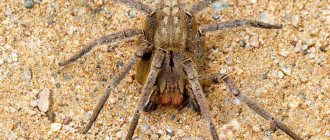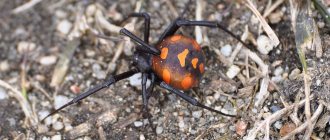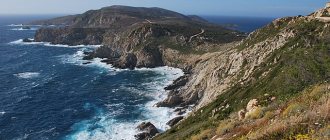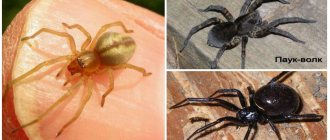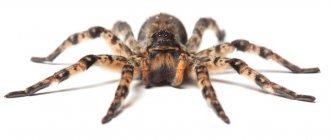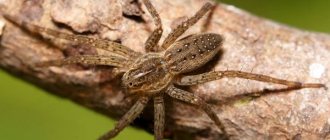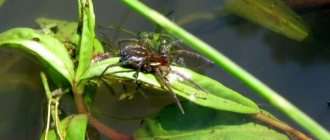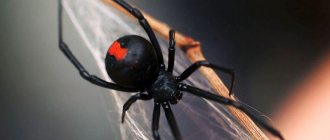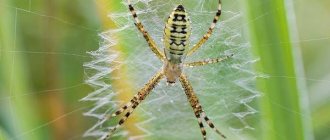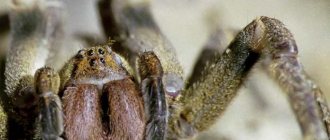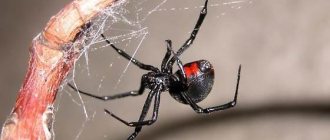- Wild animals
- >>
- Arachnids
The karakurt spider is one of the most dangerous and poisonous creatures on earth.
The name of the spider in translation means “black worm”. In the Kalmyk language, the name of the species means “black widow.” It fully justifies itself and is due to the ability of a female individual to eat male individuals after mating. Spiders also pose a great danger to humans, especially females that have reached puberty. They tend to move very quickly. It has been scientifically proven that the venom of karakurt is 15-20 times stronger than the venom of the most poisonous snake. Male individuals are much smaller in size and are unable to bite through human skin and cause harm. This type of spider is very often associated with mysticism. This is explained by the presence of thirteen red spots on the spider's body.
Origin of the species and description
Photo: Karakurt spider
Karakurt belongs to the arthropod arachnids, is a representative of the order of spiders, the family of web spiders, classified in the genus black widows, a species of karakurt.
The exact period of origin of the ancient ancestors of modern spiders - arachnids - is quite difficult to establish, since they do not have a shell, and the chitinous layer is destroyed quite quickly. However, scientists and researchers still manage to occasionally discover such finds. Most often, the remains of the ancient ancestors of modern spiders were preserved in amber. The discovered findings made it possible not only to recreate the external image of the ancient ancestor of arthropods, but also to obtain entire pictures in the form of a frozen mating process, or weaving a web.
Video: Karakurt spider
Ancient amber finds allowed scientists to conclude that spiders already existed approximately 300 - 330 million years ago. On the territory of modern China, scientists have discovered fossils of ancient arthropods. In these finds, the shapes and body structure of insects were very clearly visible. It is in this area that the remains of the most ancient spider, Attercopus fimbriunguis, were discovered. The ancient representative of arthropods had small sizes, not exceeding five millimeters, and a long tail, which was about a fifth of the length of the body.
It was used by insects to secrete sticky threads. They were involuntarily released and used by ancient spiders to line burrows, wrap cocoons, and attract individuals of the opposite sex. Ancient arthropods of that time had a slightly different body structure. In addition to having a tail, which is absent in modern insects, they had an incompletely fused head and abdomen.
Presumably the first spiders appeared on Gondwana. With the formation of Pangea, they rapidly began to multiply and inhabited almost all parts of the Earth. Subsequent ice ages somewhat reduced the habitat areas of arachnids. These insects were characterized by fairly rapid spread and modification. At the beginning of the Carboniferous, they tended to lose the division of the cephalothorax and abdomen. Scientists say that the remains of spiders, which date back to 150-180 million years, allow us to conclude that the arthropods of that time were practically no different from modern spiders.
Appearance and features
Photo: Karakurt spider in Russia
These species of spiders have very pronounced sexual dimorphism. The female is significantly larger than the males. The average body size of one female individual is approximately 2-2.5 centimeters, male - 0.7-0.9 centimeters. The spider is quite easy to distinguish from other arthropods. The body and long limbs are black with red spots on the abdomen. In some arthropods they may have a white edge. They often disappear after reaching puberty, leaving the body a solid black color.
The arthropod has four pairs of long limbs located on both sides of the body. The longest are the first and last pairs. The two pairs of limbs that are located in the middle are shorter. They are covered with special hairs that allow them to easily approach a victim caught in the viscous spider threads. Spiders have a special gland that produces powerful poison. It is designed to paralyze and kill insects. Also, with its help, karakurts kill small steppe rodents, whose burrows they subsequently occupy.
Newborn small spiders are almost transparent. However, after the first molt, the body acquires a darker shade, and whitish circles appear on the abdomen, arranged in three rows. After each subsequent molt, the insect’s body becomes darker and the circles become red. The more often a spider molts, the faster it matures. The frequency and multiplicity of molting depends on a sufficient amount of food supply. Male individuals most often, after the sixth or seventh molt, stop feeding heavily and begin searching for a female to continue the race.
Interesting fact: Surprisingly, Karakurts have blue blood. This is due to the fact that it is not the scarlet hemoglobin that is responsible for the color of the blood, but hemocyanin, which gives the blood a blue tint.
What to do after a bite?
The effectiveness of the measures taken depends on how quickly help is provided after the bite.
Cauterize the wound
It has been established that the poison decomposes under the influence of high temperature. Therefore, the first thing to do is cauterize the wound. To do this, use the means available at hand - a burning cigarette, open fire, hot metal. It is necessary to cauterize the bite site before two minutes have passed from the moment of the attack.
Magnesia injection
A composition of one tenth of a percent of potassium permanganate is administered by intravenous injection. The method of action of this remedy is similar to cauterization - heating, causing the decomposition of the poison.
The affected area is thoroughly washed and treated with antiseptic drugs.
For treatment, the most effective is a special anti-caracourt serum offered in pharmacies. You cannot cut the wound, which will increase the risk of infection, but will not remove the poison.
Painkillers
The pain symptom can be relieved with appropriate medications such as analgesics and antispasmodics. It is recommended to take the victim to a medical facility as quickly as possible, where he will receive professional assistance.
Where does the karakurt spider live?
Photo: Karakurt spider
The natural regions in which the karakurt feels most comfortable are steppes, forest-steppes, and semi-desert areas. Often this type of arthropod can be found near ravines, artificial hills, arable lands, in desert, abandoned regions, etc.
Karakurts prefer to settle in regions with a warm, dry climate. Due to climate warming, the habitat of spiders has expanded significantly. They have become quite common in Crimea, Sevastopol, even in some regions of the capital of the Russian Federation.
Geographical regions of karakurt habitat:
- forest-steppe territories of the Republic of Kazakhstan;
- steppes of the Astrakhan region;
- territory of Central Asia;
- Afghanistan;
- Iran;
- coast of the Yenisei;
- Mediterranean coast;
- Southern Europe;
- North America;
- Crimea;
- southern part of Russia.
The burrows of small rodents are chosen as a place for permanent residence, and they are killed using strong poison. I can live in dry ditches, wall crevices, secluded corners. They especially love various construction sites and abandoned buildings with many secluded and inaccessible places.
Climate change may cause migration. Spiders are afraid of cold and dampness, and therefore, when cold weather sets in, they leave their shelters in search of warmer places. In dense thickets or in a bare area under the direct scorching sun, it is unlikely that you will find this dangerous insect. The lair of the insidious black widow is entwined with a dense web.
Now you know where the karakurt spider lives, let's now see what the poisonous spider feeds on.
Behavior in the wild
The animal is more often found in desert steppe areas. Favorite habitat is the slopes of ravines, ditches, arable lands, wastelands. The spider sets up its lair, preferring to use the features of the terrain, giving preference to:
- abandoned burrows of other animals;
- rock and earthen crevices;
- depressions in the soil.
The arthropod often settles in abandoned buildings, but sometimes it is found in utility rooms and penetrates residential buildings.
The animal avoids smooth and level terrain and areas with high humidity. Karakurt chooses uneven and rocky habitat.
Having made a nest, the spider weaves cocoons for its offspring, and a web is stretched nearby to catch prey. Unlike most domestic species of arthropods, whose network is made of concentric circles, in karakurt it looks different. The threads are parallel to the ground, without obvious visible symmetry of the structure.
The arthropod is highly fertile. Peaks of sharp increases in population numbers are observed with a certain frequency - every ten or twenty-five years.
Eggs are laid by the female from mid-summer. The spiderlings are born a week later. The offspring remains in a warm cocoon, which can protect against severe frosts, and spends the winter in it. With the onset of stable warmth, by mid-April, the wind carries the cubs around the area, along with the remains of the web. The young generation reaches sexual maturity in June, acquiring the ability to further reproduce.
What does the karakurt spider eat?
Photo: Poisonous karakurt spider
The main diet of poisonous spiders is insects. To catch them, spiders weave webs, which they hang on tree branches, in the grass, etc. The web of females is denser than that of males. It is noteworthy that spider webs are not very viscous, and therefore the victim who gets caught in them will no longer be able to get out. Having caught their prey, the spiders first immobilize it with poison, and then suck out the liquid contents of the body.
What serves as the food supply for karakurt:
- flies;
- horseflies;
- locusts;
- grasshoppers;
- beetles;
- mosquitoes;
- caterpillars;
- bloodworms;
- other arthropod species;
- snakes;
- lizards.
In rare cases, small invertebrate animals that get caught in the web and cannot get out of it can serve as a food source.
It is worth noting that the venom of these spiders can kill even animals such as a cow, horse or camel. Only hedgehogs and dogs can easily tolerate it. For humans, insect venom poses a great danger. It is considered to be most toxic during marital relations. It should be noted that even the venom of a small spider is enough to kill an adult, strong man. The venom has a pronounced paralytic effect, which instantly immobilizes the spider's victim.
Features of character and lifestyle
Photo: Karakurt spider in Crimea
This type of poisonous arthropod loves dry, hot weather. That is why their habitat region is strictly limited to warm, southern countries. Recently, cases of appearance and spread on the territory of the Russian Federation have become more frequent. Here they pose a serious danger to the population, since people do not always have information about their proximity to dangerous insects. Often, when cold weather sets in, they can penetrate directly into a person’s home.
They also cannot tolerate extreme heat and heat, and therefore, after the onset of extreme heat in some countries, they migrate to more northern regions. Spiders make their lair in inaccessible places - burrows of small rodents, crevices of concrete walls, low thickets of vegetation, and other places. The spider received its second nickname “black widow” because the female eats the male after mating. Moreover, this happens with each subsequent partner.
Interesting fact: By eating their partners, females receive the necessary amount of protein, which future offspring will later need.
Scientists claim that even if, in rare exceptions, males manage to avoid the sad fate of being eaten, they still die, as they lose all interest in food and instinctively stop eating it. Karakurts tend to lead a rather hidden lifestyle. They can attack or attack only when they sense danger.
Effect of poison
Male black widows are not particularly aggressive. They prefer to run away rather than attack when danger appears. Females defend themselves with bites.
Karakurt poison is considered one of the most dangerous. It contains a neurotoxin, which spreads very quickly through the lymph throughout the human body. The degree of toxicity may depend on the season, the age of the spider and its gender. With timely assistance, death can most often be avoided.
A person does not always immediately notice that he has received a bite. The pain from it is commensurate with a pin prick. The first symptoms when poison enters the body:
- A small red dot forms at the site of the bite, which soon becomes invisible.
- Headaches and dizziness begin. Loss of coordination.
- Severe nausea, vomiting.
- The abdominal muscles contract involuntarily.
- Increased sweating.
- Severe pallor.
- My knees begin to tremble.
- Pain in the chest, back and abdomen.
- Shortness of breath, palpitations.
- No urination occurs.
If help is not provided in time, at the next stage the person will experience increased activity. He is trying to go somewhere and do something. Literally cannot find a place for himself. The person is very worried and does not calm down.
At a later stage, activity subsides. The person is in a depressed state. He has a confused mind.
Although death is not observed so often, if a person initially had a weakened immune system, he may die 3-4 days after the bite. Old people and children are especially vulnerable to poison.
Social structure and reproduction
Photo: Karakurt spider in the Rostov region
This type of arthropod is characterized by a high degree of fertility. Every 9-12 years there is an incredibly high birth rate of these dangerous insects. The mating season begins at the height of the summer season. Before the start of the breeding period, the female looks for a secluded place. The male lays out a web that contains special pheramones that attract individuals of the opposite sex. Seeing his partner appear, the male performs something similar to a dance. He sways from side to side, moves his limbs.
After mating, the female mercilessly eats her partner and begins to look for a suitable place to lay eggs. Once a place is chosen, she carefully weaves it with a web, on which she lays out the cocoons. After the mission is completed, the female dies. The cocoon reliably protects the eggs from damage and cold. If strong winds blow in the fall, they tear off the cocoons and can carry them far into the steppe, spreading the spiders’ habitat.
From the moment the eggs are laid, small insects appear after about two weeks. However, they are in no hurry to leave the cocoon, as they are waiting for the onset of spring and warming. During the first time they are in the cocoon, they exist due to the accumulated nutritional components. Subsequently, they begin to eat each other, as a result of which we can say with confidence that the strongest individuals emerge from the cocoon in the spring.
The growth and development of spiders continues throughout the spring and summer period. During this period, each individual goes through 5 to 10 molts. The exact amount depends on the amount of food and gender. Females shed more than males.
Interesting fact: The body of the spider is covered with a chitinous shell, which limits the growth and development of the arthropod. During the molting process, the karakurt sheds its shell, replacing it with a new one, larger than the old one in size.
Natural enemies of the karakurt spider
Photo: Poisonous karakurt spider
Despite the fact that karakurts are considered one of the most dangerous creatures on earth, they have enemies in their natural habitat. The greatest danger to them is posed by herd ungulates, since in huge numbers they trample not only the arthropods themselves, but also their cocoons with eggs.
In addition to ungulates, the enemies of spiders are sphex wasps. They attack arthropods in a similar way. Wasps have a special gland that produces poison, which they inject into spiders, immobilizing them. After this, the insects quietly eat the black widow.
Another enemy of poisonous and dangerous arthropods are riders. They lay eggs in arthropod cocoons. Subsequently, the emerging larvae eat the small spiderlings. It should be noted that there are other enemies that are also capable of eating karakurts in large quantities. These are hedgehogs. They are absolutely not afraid of attacks from these insects, since they are reliably protected by their shell with needles.
Spiders are also theoretically eaten by some species of other spiders or arthropods. However, they must be very dexterous and agile in order to attack the black widow before she can inject her poison. However, this happens extremely rarely, since karakurts are very fast.
In some regions, the reduction in the number of karakurts is caused by human activities associated with the destruction of rodents, as well as the use of insecticides of chemical origin.
Antidote
Black widow venom spreads quickly throughout the body. It is important to go to the hospital as soon as possible. The most effective method of overcoming the consequences of a bite is the administration of anti-karakurt serum.
The injection is given intramuscularly. You need 5-10 cubes of the drug. However, not all medical institutions have the vaccine.
Usually it is purchased only in those areas where black widows are often found. The cost of one vaccine is about $150. In addition, the shelf life of the antidote is very limited.
First aid for a black widow bite:
- the patient can be given a painkiller;
- A cold compress is applied to the bite site;
- a person should drink little but often;
- the affected part of the body must be immobilized so that the poison does not spread throughout the body so quickly.
In the first minutes, you can try to suck out the poison. But this can only be done by a person who does not have any damage to the oral cavity. Otherwise, he too may get poisoned.
If you are bitten by a spider, do not do the following:
- make an incision at the site of the bite;
- apply a tourniquet to the injured limb.
In the hospital, in order to reduce the harmful effects of toxins on the body, calcium chloride, novocaine and magnesium hydrogen sulfate are administered internally.
